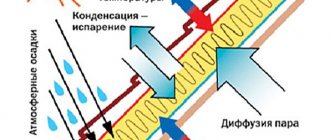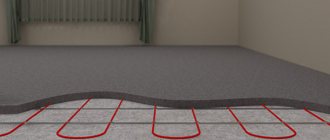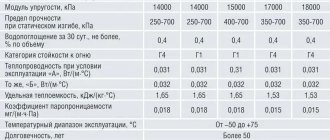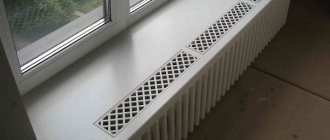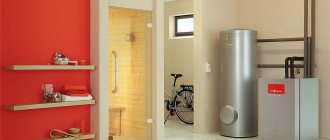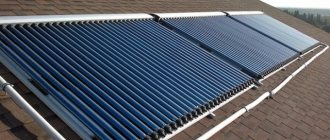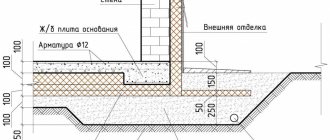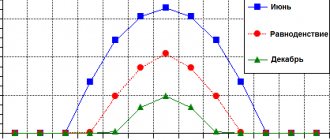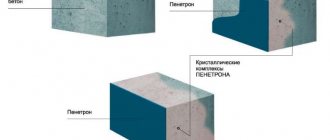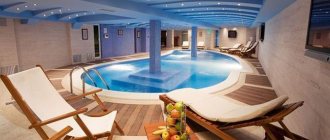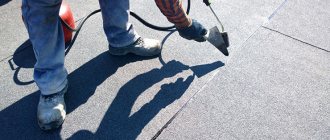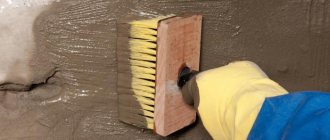Insufficiently good quality of waterproofing of a building can cause a number of troubles. The least of these are damage to finishing materials, the smell of dampness, and the appearance of fungus and mold. The biggest ones involve the destruction of walls and foundations and the need for major repairs.
Waterproofing of the cellar and basement must be provided for in the project. Any of the above troubles can be avoided if the appropriate work is carried out during the construction process. However, there are often cases when problems appear in all their beauty already at the stage of use of the building. In this case, it is best to resort to waterproofing work indoors. And this must be done as quickly as possible - otherwise the basement will regularly be flooded with groundwater and turn into a breeding ground for dampness and mold. They, in turn, will certainly climb up the walls and penetrate into the living quarters.
How to do waterproofing yourself?
Internal waterproofing work in the basement, as a rule, is carried out in conjunction with external ones. They can also be carried out if for one reason or another it is impossible to carry out work outside.
Of course, internal waterproofing work must be carried out in compliance with technological processes. Following them will allow you to achieve the desired result. In addition, it is necessary to pay special attention to such “treacherous” places as:
- joints between walls, as well as walls and floor/ceiling;
- working seams that appeared during concreting;
- cracks and fractures formed during the shrinkage of the building.
General principles
Waterproofing the floor in the basement is done in the manner provided for in the project, if such a project exists. Methods and materials depend on the budget, natural conditions on the site, and the purpose of the basement. The best results are achieved with complex work inside and outside the house. The more water in the ground, the more reliable the protection should be.
Regardless of the conditions, it is always recommended to create a so-called “pie”, that is, a cushion under the floor made of sand and crushed stone. Expanded clay is also used for backfilling, but this material quickly absorbs moisture and loses its heat-insulating properties. Therefore, it is better and cheaper to use ordinary river sand.
A rough concrete floor 8–10 cm thick is laid on the cushion. Euroroofing material and insulation are spread over it and a reinforced concrete screed is made. If desired, you can make a finishing floor on top.
Sometimes it is suggested to lay thick oilcloth between the sand cushion and the subfloor. It is better not to do this, since wet concrete has a very high percentage of water. During the shrinkage process, it needs to evaporate. But if there is oilcloth under the ceiling, the water will not be able to go into the sand and the moisture content of the concrete will be several times higher.
Types of waterproofing
The classification of waterproofing is carried out in accordance with another indicator - the degree of exposure to moisture. Based on it, it is customary to distinguish the following types of waterproofing:
- Anti-pressure waterproofing - necessary in the absence of a drainage system and/or external waterproofing, and the groundwater pressure reaches ten meters. Provides for the creation of a reliable barrier made of rubber or membrane, which will be firmly pressed to the surface that needs to be protected by water pressure;
- Anti-capillary waterproofing - necessary to protect the basement from dampness and penetration of excess moisture;
- Non-pressure waterproofing - necessary to prevent seasonal flooding or flooding due to intense rainfall. The process uses bitumen mastic.
What you need to know before you start waterproofing your basement
When deciding on the need to waterproof the basement from groundwater, find out its level in your area. In this case, it is necessary to take into account high water, precipitation and capillary penetration of water.
If the basement is used as a residential or technical building, waterproofing must be done immediately.
Waterproofing made to order at the best price!
Awning made of water-repellent tarpaulin without eyelets RUB 230. / m sq.
More details
Awning made of water-repellent tarpaulin with eyelets ⌀ 10 mm 245 rub. / m sq.
More details
Waterproofing of the pool D=3m SportStyle 9,300 rub.
More details
Waterproofing of a concrete pool 3*4m SportStyle RUB 10,400.
More details
Waterproofing, industrial geomembrane SportStyle 350 rub. / m sq.
More details
Waterproofing of a pool according to individual size RUB 400.
More details
- A serious problem will be the presence of groundwater at a depth of less than 1 m from the foundation of the house. In this case, you will have to take a set of measures to preserve the building.
In the area around the house it is necessary to carry out work on installing a drainage system. This will prevent the impact of hydrostatic pressure on the walls, possible shifting of the base of the structure and destruction of building materials. To protect the foundation, you need a reliable waterproofing layer; waterproofing will provide protection of the foundation and basement walls from capillary moisture.
- In case of deeper groundwater, there is no need to create a serious waterproofing layer. It will be enough to protect the walls with conventional waterproofing.
If it is necessary to carry out insulation work in an already built house, the owner has the opportunity to implement one of two options for their organization: from the outside or from the inside. The first option requires the participation of professionals and the use of special equipment. The second one can be done with your own hands, but the efficiency will be much lower.
Methods for waterproofing basements
Modern manufacturers offer a range of materials for waterproofing work inside basements. Some of the most popular (although not without drawbacks) are bitumen and polymer mastics, as well as built-up waterproofing.
The disadvantages of these types of waterproofing may appear after the first seasonal flooding. Under the influence of hydrostatic pressure, the waterproofing layer can swell and peel off. As for other methods of waterproofing that can withstand such phenomena, they are presented:
- penetrating waterproofing;
- membrane waterproofing;
- waterproofing with liquid rubber;
- mineral based waterproofing.
All of the above allows us to conclude that the correct choice of waterproofing material and method of carrying out work plays a vital role. The effectiveness of waterproofing work and the durability of the result depend on it. What should you pay attention to when choosing waterproofing?
- Firstly, the presence/absence of a drainage system around the perimeter of the foundation;
- Secondly - to the depth of groundwater;
- Thirdly - on the material from which the foundation is built, and on the features of its waterproofing;
- Fourthly - on exactly how the basement is used.
Necessary materials for external basement waterproofing
When answering the question: how to waterproof a basement, we can say that the very first thing that needs to be done in this direction is to make blind areas. This is the very first line of protection for both the basement and the foundation of the house from melt and rain water.
The following materials are used for the manufacture of scaffolding: cobblestone, brick, monolithic concrete, asphalt and others. Such a covering must be laid at a slight slope from the house so that water flows through the grooves dug along them in the right direction.
Preparation for waterproofing
External waterproofing of a building can be carried out using a variety of materials:
- Gray sludge K11 - this cement-based material protects the building for a long time and reliably from the internal and external effects of water on building structures. It can be applied either with a spatula, a brush or by mechanized means.
- Elastic gray slurry K11 - a coating made of this material has a strong adhesion to the base that is different from others. After hardening, it is resistant to water, frost, and also covers microcracks.
- Slurry K11 sulfatex - this material has excellent adhesion, and after a short period of time after its application, it is already able to bear the load. This material also prevents fading and does not contain any substances that would be aggressive towards metals. With such a coating, any building will receive reliable protection from moisture.
- sludge Ardalon 2K plus - quick and long-term external protection of the building from water, especially in the presence of cracks. After setting, this material acquires water-repellent properties, elasticity and resistance to the formation of any cracks up to 2 mm.
Waterproofing material
- MS - polymer aquablocker - has high adhesion to all kinds of building materials. Capable of bridging cracks up to 10 mm. Can be purchased ready-made and applied with a roller or brush. This material will qualitatively protect the building with minimal labor intensity. It is also completely harmless to the environment.
- SK film differs from other materials in that such a self-adhesive ready-made film is capable of quickly and sufficiently efficiently performing external waterproofing of a house. It also helps create a reliable, uniform coating.
- Bituminous masses are quite stable against saline solutions, wastewater and liquid manure. Waterproofing basement walls with this material is reliable and perfectly covers cracks.
Basic rules for waterproofing a basement from the inside
Of course, there are several technologies for carrying out waterproofing work - however, there is a set of general rules, following which you can achieve excellent results. They provide the following:
- Before carrying out waterproofing work, it is necessary to remove all water from the basement or wait for it to clear on its own;
- The choice of waterproofing materials should be limited to those that allow you to do the work yourself;
- Carrying out preparatory work on the walls involves removing dirt, dust and old finishing or waterproofing materials from them;
- Some types of waterproofing are applied to wet surfaces, but others require them to be completely dry;
- Cracks in the walls and floors need to be widened, cleaned of dirt, and primed;
- Waterproofing walls is impossible without a primer - it is a mandatory step, since it provides additional reinforcement to the walls and also has a positive effect on adhesion indicators;
- When carrying out waterproofing work in a new house, which may shrink, it is necessary to carry out preparatory work using geotextiles;
- Before carrying out waterproofing work on a dirt floor, you must first fill it with crushed stone and fill it with cement;
- Do not forget about waterproofing the flights of stairs leading to the basement.
Materials for internal basement waterproofing
Internal waterproofing of the basement floor or its walls is also important to protect against the harmful effects of water on it. Of course, it was best to completely repair the damp basement: apply a new bitumen layer, install new drainages and use a special film to protect against any mechanical damage.
But such work is possible only during the construction of the building, and not during its operation. Thus, it is possible to waterproof the inside of the basement.
Waterproofing material
The following materials are used for basement waterproofing:
- Liquid rubber. In essence, the use of this material is a coating waterproofing. This material fits perfectly even on damp or damp surfaces. You can also do the work yourself.
- Penetron. This is a penetrating material for waterproofing reinforced concrete and concrete structures. It perfectly penetrates the structure of concrete, despite its age and appearance, and thereby provides good water resistance to all structures.
- Bitumen mastics create an elastic membrane on the surface of basement walls that becomes resistant to deformation. Depending on the height of groundwater and the degree of permeability, such bitumen mastics come in several types according to the degree of protection: light, medium and heavy waterproofing.
External waterproofing
Penetrating mixtures
The formula of penetrating mixtures requires the presence of special reagents called penetrates. They cause the crystallization of mixtures after they are applied to the surface and penetrate into the material (to a depth of 60 cm) through microscopic cracks and capillaries. The effect of penetrating mixtures is such that it allows not only to increase the impermeability of concrete, but also to make the material itself stronger. The advantages of penetrating waterproofing are as follows:
- excellent waterproofing properties;
- resistance of concrete structures to low temperatures;
- ease of work;
- durability;
- maintaining the vapor permeability of the concrete structure.
Penetrating waterproofing
If capillary moisture and dampness are observed in the basement of a lived-in private house, waterproofing can be done using penetrating or coating materials. They are applied to concrete and hermetically seal microcracks through which water leaks.
Application of a penetrating waterproofing compound.
Penetrating waterproofing is a mixture of sand, cement and chemically active substances. The material penetrates deeply into concrete and crystallizes, filling capillaries and cracks.
Unlike other materials, penetrating waterproofing is the most liquid. Such a substance is able to penetrate deeper into a porous and fine-grained surface, creating a deep layer protected from moisture.
- Penetrating waterproofing requires a wet surface. Before use, the concrete is cleaned of debris and moistened with water.
- If there is mold on the floor or walls, it must be removed and the area treated with a fungicide.
- Places of chips and cracks are slightly expanded with a spatula.
- The solution is applied with a wide brush. It is carefully driven into the surface, especially in those places where the concrete is damaged. For deep cracks, you can use a syringe or spray.
- Penetrating waterproofing dries in 1.5 – 2 hours.
- After this, defects on the surface can be sealed with cement or an airtight seal.
Penetrating waterproofing has several important advantages:
- the resistance of concrete to cold increases, since there is no expanding moisture in the capillaries;
- corrosion of reinforcement is reduced;
- the solution is combined with concrete and does not peel off during the operation of the floor;
- the material is non-toxic and can be used to seal a food cellar.
Materials for penetrating waterproofing of different brands differ in the quality of composition and technological features of production, but the method of their application is generally the same. Some solutions are added to concrete when laying the foundation of a house.
Liquid rubber can be used together with penetrating waterproofing. The coating is quite elastic, so there is no need to level the surface before application. The material is sold in semi-finished condition. Before use, it must be stirred using a drill attachment.
How is the work carried out?
Before applying drooping mixtures, it is necessary to thoroughly clean and degrease the surface. The preparation of the working solution is carried out in accordance with the instructions and involves adding water to the dry mixture. The solution is applied to pre-moistened concrete and involves treating corners and joints first. Only after this is it applied to the rest of the surface. After 2–3 hours, another layer is applied. In order to ensure uniform hardening of the mixture, the treated surface is moistened for several days.
Materials for injection waterproofing
Injection waterproofing is a type of penetrating waterproofing. It is carried out using flowable gels made of polyurethane, acrylate or epoxy and consists of introducing the gel into previously prepared holes. The advantages of using materials for injection waterproofing are obvious:
- affordability in terms of price;
- the ability to work even on wet surfaces;
- the ability to carry out work at any temperature;
- no need for preparatory work;
- the ability to carry out waterproofing work even in hard-to-reach places.
However, there is one drawback, which is that special tools and knowledge of technology are required to carry out the work. Therefore, independent implementation is impossible.
Waterproofing with bitumen
Waterproofing using bitumen mastic has become widespread. This is a budget, simple and effective way to protect the room from moisture. This method is best suited for those people who do not have experience in performing waterproofing work. The following tools will be needed for this work:
- Bitumen mastic;
- Bitumen primer;
- Construction brush;
- Respirator;
- White Spirit.
Before proceeding with the actual installation, the wall is thoroughly cleaned of dust and sand. Next, a layer of bitumen primer (primer) is applied. The technology is simple and does not differ from the process of applying conventional water-based paint. When applying primer, you need to ensure that the wall acquires a rich black color. This may require applying several layers. The applied primer, which acts as an impregnation, is left to dry.
It takes 20 minutes to dry the layer at a temperature of 20 degrees. The average consumption of bitumen primer per square meter is 250-300 ml.
Next, bitumen mastic is applied over the primer. Mastic can be purchased as a ready-made mixture. There are times when the consistency is too thick, so you can thin it out a little with white spirit. After thorough mixing, the mastic must be heated to a temperature of 40 to 500 degrees. The mixture can be applied with a brush or roller; level with spatulas. It takes 1-2 days for complete drying . After this, a second layer is applied. That's it, the waterproofing is ready.
Before filling the trench, you can install thermal insulation for additional protection against possible condensation. To do this you will need sheets of polystyrene foam or polystyrene foam. They are attached around the perimeter of the entire foundation.
Roll waterproofing
The concept of roll waterproofing is a collective one and unites a whole group of materials made on the basis of bitumen or polymers. Along with materials that have already become traditional and have been used for a long time, new ones have appeared, such as:
- glass ruberoid;
- folgoizol;
- brizol.
Installation of these materials involves gluing and cold or hot bitumen mastic, or fusing. The advantages of roll materials are as follows:
- ease of work;
- low cost of materials.
As for the shortcomings, there are many of them:
- sensitivity to low temperatures;
- susceptibility to microorganisms.
Coating waterproofing
Coated insulation is best suited for you if the problem of capillary moisture penetrating into the basement is a pressing issue for you. Waterproofers of this type are presented in the form of mastics, which must be applied to the walls using a spatula and other tools. As soon as the insulator dries after application, a monolithic film will be formed on the surface, which will provide protection from moisture for a long time.
Coating waterproofing is performed using special mastics.
For many years, bituminous mastics have been the market leader in coating waterproofing materials. Without a doubt, they are effective. But their main drawback is their limited service life. The service life of a bitumen-based insulator does not exceed several years.
The modern market offers a solid range of hydrophobic materials that fall into the category of coating waterproofing. Most of them are made on the basis of polymers and minerals. Their composition, as a rule, includes special modifiers, which make it possible to provide all the necessary properties of the material.
The main advantages of modern coating waterproofing:
- Ease of use, ease of application to the wall surface, elasticity of the composition.
- Goes well with concrete walls and any other surfaces made from mineral materials.
- Durable, reliable and effective insulator.
- Reasonable prices for compositions designed for use in basements and cellars.
Experts recommend choosing hot mastics made from polymers, as well as unique cold-applied epoxy and rubber compounds. Of course, the cost of such insulators is quite high.
Waterproofing with membrane
Membrane waterproofing is one of the types of roll waterproofing and involves the use of a special membrane. Visually, it looks like a canvas that has many cone-shaped spikes to drain water. The advantages of membrane waterproofing are as follows:
- long lasting effect;
- Possibility of application to any surface;
- ease of work.
As for the disadvantages, they consist in the need for mandatory horizontal waterproofing.
Waterproofing of structures buried in the ground (waterproofing of basements and foundations)
Waterproofing of buried structures, underground structures and foundations
The construction of underground structures and buried structures necessarily includes measures for high-quality and durable waterproofing. Given the difficult operating conditions, protection from moisture must be sealed, resistant to aggressive environments and various types of loads. The economic feasibility of waterproofing the buried parts of a facility under construction is determined primarily by the fact that repairing such structures is practically impossible or requires enormous resources, including labor and financial resources. If we are talking about the reconstruction of large tunnels, buildings, parking lots and other structures in the industrial and civil construction segment (
ASG
)
, then reconstruction work, as a rule, entails additional costs for providing special conditions - fencing the territory, blocking traffic if necessary. It is worth considering that the absence of waterproofing or its poor-quality installation can have serious consequences for load-bearing structures - cracks, deformations, destruction; if the buried part is exploited, then operation becomes impossible, in addition, there is a risk of damage to property.
In the construction of buried structures, bitumen-polymer mastics, polyurethane compounds, bitumen-polymer roll materials, as well as polymer membranes are actively used. The choice of this or that material is determined primarily by the scope of application, installation and operation features.
The range of TECHNONICOL waterproofing is extremely wide and includes several items in each segment.
TECHNONICOL bitumen-polymer materials:
TECHNOELAST GREEN
– a material used for waterproofing green roofs and underground building structures. Thanks to special anti-root additives in the bitumen-polymer binder, waterproofing prevents plant germination and reliably protects the structure from moisture penetration. The surface of the material is additionally protected by a thick polymer film on the front side, which makes it resistant to mechanical stress.
TECHNOELAST ALPHA
— a waterproofing membrane made from a polyester base combined with a special gas-insulating aluminum screen,
on both sides of which bitumen-polymer binder is applied. TECHNOELAST ALPHA protects underground premises from dangerous inert gases such as radon and methane.
TECHNOELASTMOST B
- a waterproofing fabric consisting of a durable, rot-resistant polyester base, onto which high-quality bitumen-polymer binder is applied on both sides. Thanks to the unique binder recipe, the material has increased strength and wear resistance. TECHNOELASTMOST B is intended for waterproofing reinforced concrete slabs of roadways of bridge structures and waterproofing other building structures.
TECHNOELASTMOST S
– a waterproofing material with a heavy-duty base, coated with a special binder, has maximum wear resistance, strength, and can withstand high temperatures (up to 220° C).
The material is used for waterproofing at transport and road facilities of federal significance. TECHNOELASTMOST S is designed for installing a protective adhesion layer on an orthotropic steel and reinforced concrete roadway slab. It is allowed to lay asphalt concrete (at temperatures up to 220° C) directly on the waterproofing.
TECHNOELAST BARRIER (BO) is a waterproofing sheet consisting of a thick polymer film on which a self-adhesive binder of a special composition is applied. The back side of the canvas is covered with a protective film, which can be easily removed. Due to the absence of a base, the material has high elasticity and flexibility, which allows it to be successfully used not only in the construction of shallow foundations, but for internal waterproofing and vapor barrier of building structures.
TECHNOELAST BARRIER (BO) MINI
- used for waterproofing floors, foundations, pipes. The material consists of a thick polymer film, onto which a mixture of bitumen-polymer binder is applied. The underside of the canvas is covered with anti-adhesive film. The baseless material is very elastic, which allows it to maintain integrity when protecting pipes from corrosion, when sealing seams and joints in building structures. Can be laid on flammable substrates.
TECHNOELAST TERRA
– single-layer waterproofing of buried structures. The material is made on a polyester base, closed on both sides with a bitumen-polymer binder. It is highly resistant to static punching and hydrostatic pressure. The reinforced base allows it to be laid without gluing to the base on the horizontal part and with mechanical fastening on the vertical. The top protective layer of fine-grained powder protects the material from excessive heat. The bottom side is covered with a low-melting polymer film. Overlapping panels can be fused with a gas torch or hair dryers using hot air.
TECHNOELAST FLEX
— is a rolled waterproofing bitumen-polymer baseless material. It has high elasticity (relative elongation more than 1000%) and low melt viscosity, which significantly simplifies the work when constructing expansion joints, where bitumen-polymer roll materials of the TECHNOELAST series are used as a waterproofing membrane.
Foundation waterproofing TECHNONICOL
— self-adhesive material for waterproofing the foundation, depending on the groundwater level, installed in one or two layers. On the upper side, the waterproofing is covered with a film, which reliably protects against mechanical damage and exposure to aggressive environments. The self-adhesive bitumen-polymer layer is highly elastic, due to which the material remains intact even in the event of micro-movements and the formation of cracks in the foundation. On the underside, the material is protected by an anti-adhesive film, which is removed during installation.
TECHNONICOL cut-off waterproofing
designed to protect structural elements of a building (walls, partitions, mauerlat) from capillary rise of moisture. The rolled material is laid loosely and secured using cement-sand mortar or bitumen mastic. If the installation of load-bearing structures is carried out immediately after laying the material, you can do without fixing compounds; the load-bearing elements will be enough to fix the waterproofing.
TECHNONICOL polymer membranes
LOGICBASE
V - SL
is a polymer membrane for waterproofing underground parts of buildings and structures. Non-reinforced two-layer waterproofing material is made on the basis of high-quality plasticized polyvinyl chloride (PVC). The front surface of the membrane is yellow, the back surface is black. The membrane is produced with a standard sheet thickness of 1.5 and 2.0 mm, length - 20 m, width - 2 m.
LOGICBASE
V - ST -
a light green waterproofing polymer membrane is also produced on the basis of plasticized polyvinyl chloride (PVC). One of the sides of the material has a special textured surface, which does not allow membranes in two-layer waterproofing systems to stick together during vacuum quality control. The standard material thickness is 1.6 mm.
Polymer membranes are used to perform reliable waterproofing of tunnels, foundations, stylobates, underground parts of buildings and structures. Installation of this group of materials is carried out with hot air using special welding equipment.
Technical solutions based on polymer membranes and a control and injection system make it possible to monitor the integrity of waterproofing at all stages of construction and operation, and if leaks occur, carry out repairs with minimal financial costs.
TECHNONICOL mastics
MASTIC No. 21 TECHNONIKOLTEKHNOMAST
- completely ready-to-use mastic, designed to protect structures (foundations, basements, piles, objects buried in the ground or in contact with a damp environment). The material contains petroleum bitumen modified with artificial rubber, as well as mineral fillers and an organic solvent. Forms a high-strength coating with a wide range of operating temperatures
MASTIC No. 24 TECHNONICOL MGTN
- a completely ready-to-use material based on petroleum bitumen, containing technological additives, mineral fillers and solvent, used for coating waterproofing of concrete, wooden and other building structures (foundations, basements, piles).
MASTIC No. 31 TECHNONICOL
– emulsion roofing mastic. This is a ready-to-use material consisting of a water emulsion of petroleum bitumen modified with artificial rubber, technological additives and fillers. Coatings based on it have high elasticity, heat resistance, and are resistant to moisture. The material is water-based, does not contain solvents, has a neutral odor, and is ideal for indoor use.
MASTIC No. 33 TECHNONICOL SPRAYED
water-based material obtained using the technology of dispersing bitumen in an aqueous solution of emulsifiers
with latex modification, does not contain solvents. With mechanized application, it can significantly reduce the time required to complete the work. Coatings based on it have a wide range of operating temperatures.
Polyurethane compounds TECHNONICOL
TAIKOR ELASTIC 300
is a polymer composition for seamless elastic waterproofing; when applied to the surface, it forms an elastic waterproof film.
Waterproofing materials
: TECHNOELASTMOST Technoelast EMP 5.5 Technoelast ALPHA Technoelast GREEN Technoelast BARRIER Technoelast EPP Roofing mastic TECHNONICOL No. 21 (Tehnomast) Waterproofing mastic TECHNONICOL No. 24 (MGTN) Water-emulsion mastic TECHNONICOL No. 33 Mastic for roofing and hydraulic insulation works TECHNONICOL No. 31 Hot roofing mastic TECHNONICOL No. 41 ( Eureka)
Where can I buy?
Waterproofing with liquid rubber
A material such as liquid rubber is a cold-applied mastic, which is made on the basis of two components. It is an environmentally friendly material and does not release toxic compounds into the space, and is also distinguished by the fact that it hardens very quickly after application. The advantages of liquid rubber waterproofing are its immunity to the effects of:
- putrefactive processes;
- ultraviolet rays;
- water pressure;
- temperature changes;
- bacteria and fungi.
But that's not all. In addition, liquid rubber is different:
- long operational period;
- affordable price;
- ease of repair;
- excellent adhesion performance.
Waterproofing with liquid glass
To make a material called liquid glass, sodium silicate is used, to which sand and soda are mixed. To prepare a waterproofing mixture, the starting material in powder form is mixed with water. The advantages of liquid glass are as follows:
- ease of waterproofing work;
- possibility of repairs;
- excellent waterproofing characteristics.
As for the disadvantages, they are that liquid glass is not suitable for any surface.
Materials for emergency sealing of leaks
Sometimes it becomes necessary to fix leaks in the basement walls instantly to avoid flooding. For this purpose, cement-based products are used with an instant hardening time of about 10 seconds from the beginning of contact with water.
One of the most popular means of such action is considered to be the Gambit hydroseal. The manufacturer guarantees long-term water resistance of the product even under adverse climatic conditions.
The methods of working with the protective agent are simple, but have their own specific features:
- The leaking surface must be cleaned of various separating layers in the form of oils, greases, weak layers of plaster, dust and dirt.
- Application is done with a hand wearing a smooth glove: the dry hydroseal mixture is compressed in a handful until it is as compact as possible and immediately pressed into the leak hole until the water stops completely.
- If the pressure is significant, you should first quickly mix the composition in water to a thick paste and plug the hole with the resulting lump with a strong fixation.
- The manufacturer has provided the possibility of simplifying the work by using nylon containers up to 2 cm wide and a maximum length of 20 cm. The container is removed from the sealed packaging, moistened, crimped and fixed in a crack or leaking seam.
- After eliminating the leak, additional strengthening and sealing of the seam or crack is carried out using special compounds from the same manufacturer, which are offered to the buyer separately.
- Upon completion of work, you must immediately wash the tool and any possible contaminants in the water.
- Material is purchased at a calculated consumption rate of 1.5 kg per dm2.
Other manufacturers produce similar products for eliminating pressure leaks, the principle of operation of which is similar.
How is the work carried out?
Waterproofing with liquid glass is carried out in several stages:
- preparatory work is carried out to clean and degrease the surface to be treated;
- Liquid glass is first applied to corners, crevices and joints, and then the entire surface is covered with it.
Application of the material should be carried out as quickly as possible, since the finished mixture hardens very quickly. You can also add liquid glass powder to the plaster - this will make it more reliable.
How to protect the cellar from moisture as much as possible?
Every owner of a private house has probably at least once in his life wondered how to waterproof the basement. This procedure requires relatively little effort and can be carried out even without the involvement of specialists. Note that penetrating waterproofing of the basement from the inside directly depends on how correctly the outer part of the foundation was processed. If the problem has already made itself felt, it can only be eliminated with the help of comprehensive internal insulation. Before waterproofing the cellar, a number of preparatory works are required:
- inspect the blind area for damage and strengthen it;
- detect sources of moisture entering the basement;
- clear the foundation (seams and cracks must be completely sealed);
- isolate seams and joints of the foundation from moisture;
- ensure stable ventilation.
Only after completing these priority measures is it recommended to begin planning the territory and draining wastewater from it. It is necessary to examine the type and condition of the soil on the site and determine the depth of groundwater. Depending on the data obtained, you can decide on the most optimal method of waterproofing.
Protecting the cellar from moisture
Waterproofing with cement-based polymers
Waterproofing carried out using cement-based polymer compounds is called coating. She may be:
- hard - carried out using a dry cement mixture;
- flexible - carried out using a dry cement mixture and polymer emulsion.
The advantages of such coating waterproofing are as follows:
- ease of work;
- elasticity of the material;
- availability of material.
As for the disadvantages, they consist in the fragility of such waterproofing.
Construction of houses
76 votes
+
Vote for!
—
Vote against!
Protecting a basement from water is one of the main tasks during its construction. It includes a whole range of measures to ensure the watertightness of the basement walls and floor, as well as to prevent the rise of water inside the structure through the capillaries. The most reliable waterproofing can only be done at the construction stage; all subsequent work will be only half measures that will not give a long-term and sustainable result. But what to do if you bought a ready-made house and discovered that there is often water in the basement? What measures to take, what materials to use. In this article, we will tell you how to waterproof a basement in an existing building and what materials to use for certain jobs.
- What type of basement waterproofing can it be?
- Waterproofing basements: materials and technologies
- Coating waterproofing materials
- Pasting waterproofing materials
- Water repellents
- Penetrating waterproofing
- Waterproofing the basement from the inside
- Penetrating basement waterproofing
- Basement waterproofing with liquid rubber
- Waterproofing the basement from the inside: video - review
What type of basement waterproofing can it be?
Before moving directly to waterproofing materials, I would like to clarify what we will protect our basement from. In total, there are three types of waterproofing: anti-pressure, non-pressure and anti-capillary.
Anti-pressure waterproofing of the basement is necessary when the groundwater level is higher than the basement floor, and sometimes the walls too, or if there is a seasonal rise to this level during spring floods. Such waterproofing is installed only on the outside of the wall and floor structure. Materials are used that can withstand so-called positive water pressure. This is when water presses its weight against the surface of a structure, such as a wall. But waterproofing the basement of a house from the inside with these materials is useless, since negative water pressure acts there, causing the material to separate from the surface. In addition to this, if groundwater is high, it would be a good idea to install drainage around the basement to drain the water into a drain well or sewer.
Non-pressure waterproofing of the basement is protection against water accumulated due to precipitation or floods. Of course, if anti-pressure waterproofing has already been carried out, then there is no point in non-pressure waterproofing. But if the groundwater level in the area is quite low and there is no likelihood of its seasonal rise, then you can only get by with non-pressure waterproofing measures, for example, coating the floor and foundation walls with bitumen mastic.
Anti-capillary waterproofing is designed to prevent water from rising through capillaries in concrete foundation walls and floors. This will protect the structure of the house from destruction. If previously, to protect the walls of a house from rising moisture, they simply coated it with bitumen or covered the top of the foundation with roofing felt before arranging the walls, but today the use of penetrating waterproofing is gaining more and more popularity.
Waterproofing basements: materials and technologies
The modern market is saturated with various waterproofing materials. Conventionally, they can be divided according to the method of application and principle of action into several categories: coating, roll, water repellent, penetrating or injection. Each of them is good in its place.
Coating waterproofing materials
This very broad category includes a variety of emulsions, bitumen-based mastics that can be applied both cold and hot, thick-layer bituminous coatings, cement-based compositions, and polymer coating materials.
Mastics are made from special bitumen, which is refined with synthetic rubber, and do not contain solvents. They can be applied to any strong, stable base: concrete, brick, plaster, stone and others, after moistening them. After the mastic dries, a seamless, highly elastic film is formed on the surface. This coating covers all cracks, is not afraid of cold and heat, does not allow water to pass through, and is resistant to aggressive environments. Waterproofing a basement involves applying mastic to the outer wall of the foundation to protect it from groundwater and storm water. This material can only withstand positive water pressure. Although sometimes mastics are used to fill expansion joints, so be sure to read the instructions before purchasing.
For example, bitumen mastics “Elastopaz” and “Elastomix”, which are also called liquid rubber, are applied to the surface of the floor and walls of the basement from the inside. But remember, the material is not able to resist negative water pressure for a long time, therefore, if the external waterproofing of the basement is not done, then over time the liquid rubber may break and a leak will appear.
Thick-layer bituminous coatings, one and two-component, are used only to protect house structures from pressure water; they are applied outside the foundation walls and before pouring the basement floor. Can be used on any mineral surfaces: concrete, brick, hollow blocks, sandstone, limestone, plaster, porous concrete and others.
Cement-based compositions can be divided into conventional cement coating waterproofing, cement coating waterproofing with a penetrating effect and auxiliary compositions.
Conventional cement coating waterproofing is also called armoring; it can be applied to any mineral surface. Some materials, after application, can create an elastic coating that will bridge newly formed cracks even up to 2 mm wide.
Cement waterproofing with a penetrating effect is used only on good quality concrete surfaces. If cracks and capillaries are larger than 0.4 - 0.5 mm, the material will not work.
Polymer coating waterproofing materials include polyurethane-based materials and universal materials based on MS polymers.
Polyurethane-based materials are used for durable waterproofing, used in liquid form, and are one- or two-component coatings that are applied and hardened in a cold state. It makes sense to apply these materials only on the side facing the water. In this case, it is first necessary to carefully prepare the base: it must be clean, dry, without flaws that could interfere with adhesion.
Universal waterproofing based on MS polymers combines the advantages of silicone and polyurethane. This material appeared on the market relatively recently, but has already gained confidence, as it provides reliable crack bridging up to 10 mm and water resistance at the level of a thick-walled coating, and is applied as easily as a conventional bitumen emulsion, again, on the side facing the water .
Pasting waterproofing materials
Pasted waterproofing is carried out using rolled materials by gluing them to the base in several layers. For this you can use roofing felt, glass insulation, glass roofing felt, hydrostekloizol, glass felt, hydroisol, hydrobutyl and others. Before installing the adhesive waterproofing, the surface must be carefully treated: leveled (irregularities up to 2 mm are allowed), dried, and primed with bitumen emulsion. The resulting coating is sensitive to mechanical damage, so it is imperative to protect it with a pressure wall.
Water repellents
These materials are a relatively new way to make a surface water-repellent. Water simply rolls off the surface treated with a water repellent. But when new cracks appear, the material is not able to heal them, and it does not penetrate deeply into the surface structure, no more than 5 mm, so over time it is washed out and weathered. Gradually, the water-repellent properties decrease: if the material is water-based, then after 1–3 years, and if it is solvent-based, then 5–10 years.
Penetrating waterproofing
Used to ensure waterproofness of concrete structures. The composition applied to the surface is a mixture of Portland cement, active chemical additives and finely ground quartz sand. It must be applied to a damp surface, while the active elements react with water, resulting in the formation of crystals that fill all the pores, capillaries and cracks in the concrete and do not allow water to pass through. The penetration depth of crystals is from 15 to 25 cm, but some brands claim that their material can penetrate up to 90 cm deep.
Penetrating waterproofing is a great way to seal a basement from the inside. But at the same time, it has several disadvantages: it is used only on concrete surfaces, the concrete must be of good quality, with capillaries and cracks up to 0.4 mm deep.
When wondering how to properly waterproof a basement, pay attention to the fact that almost all materials offered on the market are suitable for external waterproofing: coating, pasting, water repellents, liquid rubber and others, and for internal waterproofing you can use penetrating waterproofing. In this case, the term internal waterproofing of the basement means protecting the basement from ground or storm water, as well as capillary water. Because if you want to protect the basement from water that may appear due to leaks of communications, i.e. inside the basement, then coating materials, mastics and emulsions can be used to waterproof the floor.
Waterproofing the basement from the inside
The situation when water enters the basement, but it is not possible to carry out full external waterproofing, is not uncommon. Quite often, there is simply no external waterproofing of the foundation, or it has collapsed over time. At the same time, it is not possible to dig out the foundation and carefully treat its surface due to the fact that the houses are too close to each other or for other reasons. That is why home owners are looking for opportunities to waterproof the basement with their own hands, without resorting to excavation work.
Important! We would like to warn you right away that for high-quality protection from groundwater, waterproofing will be required on the outside of the foundation walls. This is the only way moisture will not penetrate the walls and inside the basement, pressing the waterproofing material against the wall surface. If there is no external waterproofing of the foundation walls, water will penetrate into the thickness of the walls, and then into the basement.
Waterproofing a basement from the inside with your own hands can include several types of work, for example, anti-capillary protection of concrete walls and basement floors and protection with liquid rubber.
Penetrating basement waterproofing
Among all the penetrating materials, the following can be distinguished:
- Mixtures that are applied to concrete surfaces both outside and inside structures to make them waterproof;
- Mixtures and compositions for sealing seams, cracks, joints. Used in combination with the first mixtures;
- Fast-hardening compounds that can stop a leak in a matter of seconds;
- Additives to concrete mortar that are used during the construction stage.
Before applying penetrating waterproofing to the surfaces inside the basement, it is necessary to clean the room and thoroughly prepare the concrete surfaces. This is some of the difficulty in using penetrating materials, since to clean and moisten the concrete you will have to use special equipment or do it manually. If the capillaries of the concrete are closed, the material will not be able to get inside.
Important! Penetrating waterproofing is applied only to wet concrete. It is better if it is freshly poured.
All cracks and cracks must be opened and cleared, and then sealed with material for joints and seams, for example, Penecrit.
Then, according to the instructions, prepare a solution for walls and floors, for example, “Penetron”, and apply it with a brush or roller in a layer of 1 - 2 mm. Then you need to let the first layer dry and absorb and repeat the operation. Reacting with water, the material forms hydrophobic crystals, which spread deep into the concrete structure by 10–15 cm, and sometimes more, clogging the capillaries and preventing water from penetrating not only into the basement, but also into the concrete structure.
Learn more about complex penetrating basement waterproofing video.
On the market you can choose a material more suitable for certain conditions: “Hydrohit”, “Lakhta”, “Kalmatron”, “Xipex”, “Maxill”, “Penetron”.
Basement waterproofing with liquid rubber
As an additional measure to the penetrating waterproofing of concrete, the walls and floor of the basement can be treated with liquid rubber - a modern polymer or bitumen waterproofing material.
For self-application, one-component materials are suitable, for example, “Elastopaz” and “Elastomix”, which can be applied with a roller or brush without heating. Moreover, work can be carried out at any time of the year. The compositions are sold ready-to-use; just open the bucket and mix thoroughly.
To waterproof a basement with liquid rubber, the surface on which it will be applied must be cleaned of dust and debris, dried if necessary, and leveled. In principle, careful leveling is not required, since the material itself will close all the cracks and bulges, forming a membrane, but if the height differences are too large, the material consumption will increase.
Then we apply a primer to the walls and floor, preferably the one recommended by the material manufacturer. Next, open the bucket and mix the contents using a mixing attachment on a drill.
We apply the material to the surface of the walls and floor with a roller, spatula or brush, paying special attention to irregularities, cracks and chips. And leave it to dry. After complete hardening, the material will resemble rubber.
Waterproofing with liquid rubber from the inside of the basement does not protect the walls from water penetrating into their thickness. Over time, the concrete will become saturated with water to such an extent that it will begin to tear the rubber away from the surface. Although the manufacturer claims that rubber penetrates up to 15 mm deep into concrete, in the event of severe groundwater or storm water pressure, this coating will last no more than 4 - 5 years.
Since such materials are not designed for negative water pressure, it is advisable to install pressure walls and screed the floor in a layer of up to 50 - 100 mm. This way you can guarantee no leaks for quite a long time.
Internal waterproofing of the basement is just an additional, auxiliary measure. It is not capable of providing maximum reliability. Therefore, at the first opportunity, it is still worth digging out the foundation and performing waterproofing correctly. If the groundwater is quite low and never bothers you, then sometimes it is enough to perform penetrating insulation from the inside using polymer materials or special cement-based plasters. But remember, this will not protect the walls from water accumulation.
Waterproofing the basement from the inside: video - review
How is the work carried out?
Coating waterproofing is carried out in several stages:
- preparatory work involving cleaning the walls and moistening them;
- preparation of the working mixture;
- applying the working mixture to the surface to be treated.
Thanks to this article, you learned which materials are best to use for doing waterproofing work in the basement with your own hands. Well, if you want to turn to professionals, call us!
Materials for waterproofing basement walls
The construction industry produces many types of materials for waterproofing work from the inside of underground premises. Some of them are intended for work in industrial conditions using special machinery, equipment, and devices. For waterproofing basements in private households, manufacturers offer materials that are quite affordable for doing insulation work yourself:
- The most understandable include coating and pasting types of waterproofing and their corresponding materials.
- Penetrating insulation is somewhat more difficult to perform, requires additional equipment and requires careful and labor-intensive preparatory work.
- To carry out emergency, urgent work to eliminate leaks, special compounds are produced.
In this video we will look at the technology of waterproofing premises:
Roll insulation
Roll materials are available in dozens, maybe hundreds of designs. They can be based on bitumen or polymers. The most common and popular classic options are:
- glassine;
- roofing felt;
- roofing felt;
- brizol;
- stekloizol;
- waterproofing
They can be fused to the walls using burners or glued using mastics.
The main advantages of roll pasting materials include low cost and ease of doing the work yourself.
Progress of work on gluing roll waterproofing:
- The insulated wall should be leveled, cracks repaired, dried, and covered with a layer of soil.
- Sheets of material are cut out according to size; the gluing direction can be any.
- Mastic can be applied both to walls and to the inside of rolled insulation.
- The roll is glued to the wall starting from the top by pressing tightly.
- After fixing the canvas on the wall, the roll should be smoothed according to the principle of gluing wallpaper from the center to the edge.
- The next section is glued in the same way with an overlap of 15-20 cm.
Membrane waterproofing can also be classified as roll materials. It has a different method of arranging both the material and its fastening to the surface of the walls.
The material is quite new, but based on the reliability declared by the manufacturers, it can win its rightful place in the market. Do-it-yourself installation is somewhat more complicated than simple roofing felt, but can be mounted even on a damp surface.
Coating insulation
Even the simplest painting of basement walls can be classified as coating insulating coatings. In dry soil for basement walls, a coating of any oil-based water-repellent compound is sufficient to prevent moisture from penetrating through the basement walls.
But for underground structures it is better to use more effective compounds and materials.
Liquid rubber
Thanks to a number of distinctive properties, today liquid rubber is one of the most popular materials for waterproofing:
- produced on a water basis;
- forms a waterproof membrane on the insulated surface;
- the finished surface is elastic and resistant to mechanical deformation;
- preliminary preparation of the insulated surface is minimal;
- suitable for repair and restoration insulation work;
- sets quickly, looks like a layer of rubber;
- does not contain solvents, is an environmentally friendly material;
- does not cause sagging on the walls, is resistant to temperature changes;
- used only on dry, clean, grease-free surfaces, applied in one layer;
- Available in ready-to-use form, dilution with water is not allowed;
- can be operated at temperatures from -50 to +85 °C;
- Consumption rate up to 1 kg per 1 m2 of surface to be coated;
- price range from 100 to 600 rubles. for 1 kilogram.
Protect your basement from moisture
Polymer coatings
Polyurethane and polycarbamide mastics are quite easy to use:
- refer to coating materials;
- after application they form a protective membrane that is resistant to various types of mechanical stress;
- have high adhesion to concrete, brick, stone, metal surfaces;
- often contain anti-corrosion additives;
- do not form seams, very durable in use.
Penetrating insulation
Materials for penetrating waterproofing are designed on the principle of penetration of insulating compounds deep into the surface through its pores and capillaries, followed by crystallization.
Penetrating materials
The optimal material is Penetron and similar compounds under other names.
The procedure for performing penetrating waterproofing:
- Penetrating compounds are allowed to work on brick concrete surfaces.
- The first and most important step is to clean the insulated surface from dirt, dust, unevenness, old paint and non-functional coatings, grease and oils. The best quality is achieved by using a special grinding tool for cleaning. Goal: maximum opening of the pores of the wall material.
- Next, the surface is moistened with a stream of water at maximum pressure.
- The first layer of penetrating insulation is applied to the wet, clean surface.
- The second layer is applied immediately after the first has completely dried.
